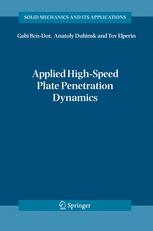

Most ebook files are in PDF format, so you can easily read them using various software such as Foxit Reader or directly on the Google Chrome browser.
Some ebook files are released by publishers in other formats such as .awz, .mobi, .epub, .fb2, etc. You may need to install specific software to read these formats on mobile/PC, such as Calibre.
Please read the tutorial at this link: https://ebookbell.com/faq
We offer FREE conversion to the popular formats you request; however, this may take some time. Therefore, right after payment, please email us, and we will try to provide the service as quickly as possible.
For some exceptional file formats or broken links (if any), please refrain from opening any disputes. Instead, email us first, and we will try to assist within a maximum of 6 hours.
EbookBell Team

4.7
36 reviewsHigh-speed impact dynamics is of interest in the fundamental sciences, e.g., astrophysics and space sciences, and has a number of important applications in military technologies, homeland security and engineering. When compared with experiments or numerical simulations, analytical approaches in impact mechanics only seldom yield useful results. However, when successful, analytical approaches allow us to determine general laws that are not only important in themselves but also serve as benchmarks for subsequent numerical simulations and experiments. The main goal of this monograph is to demonstrate the potential and effectiveness of analytical methods in applied high-speed penetration mechanics for two classes of problem. The first class of problem is shape optimization of impactors penetrating into ductile, concrete and some composite media. The second class of problem comprises investigation of ballistic properties and optimization of multi-layered shields, including spaced and two-component ceramic shields. Despite the massive use of mathematical techniques, the obtained results have a clear engineering meaning and are presented in an easy-to-use form. One of the chapters is devoted solely to some common approximate models, and this is the first time that a comprehensive description of the localized impactor/medium interaction approach is given. In the monograph the authors present systematically their theoretical results in the field of high-speed impact dynamics obtained during the last decade which only partially appeared in scientific journals and conferences proceedings.